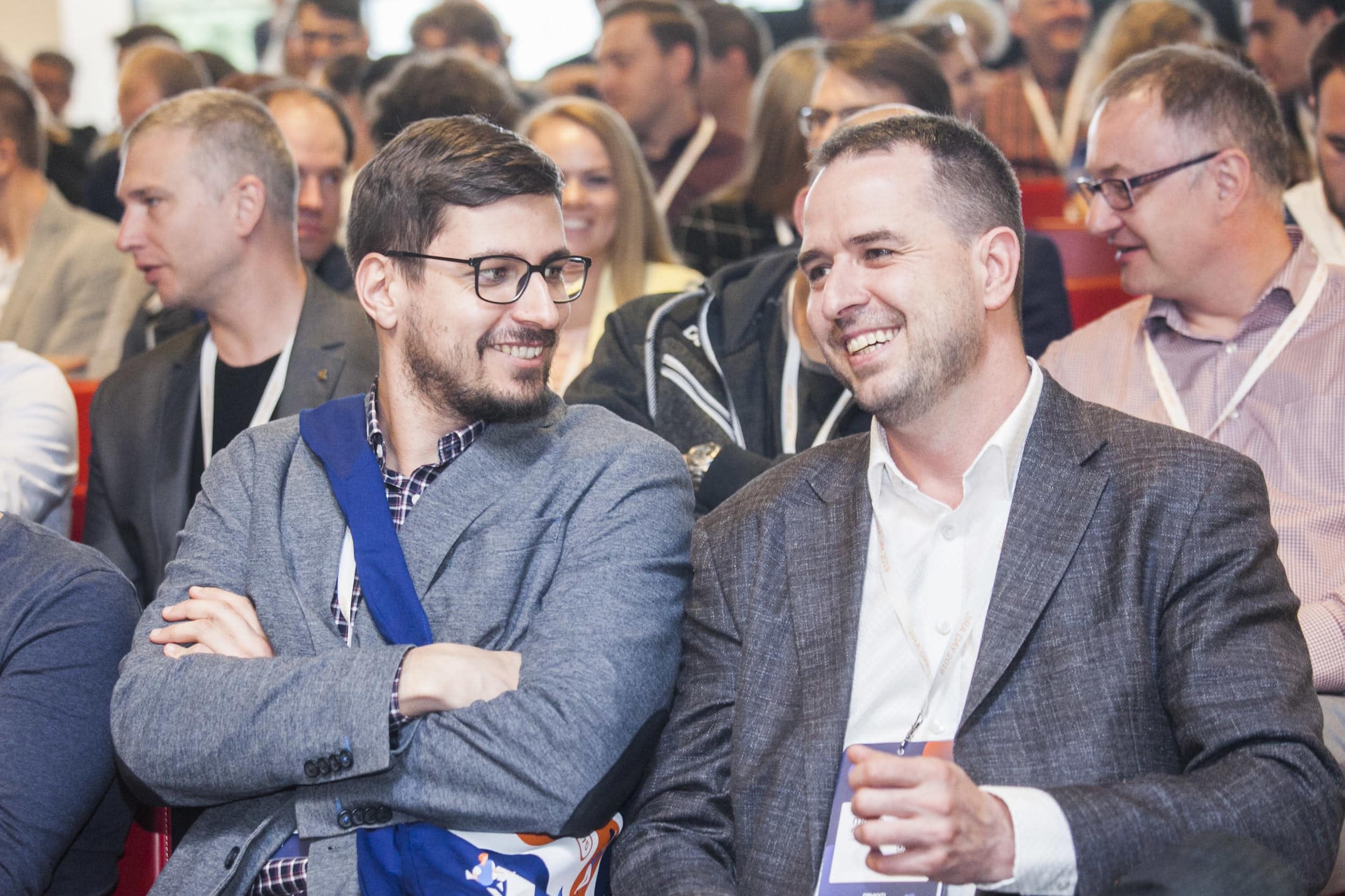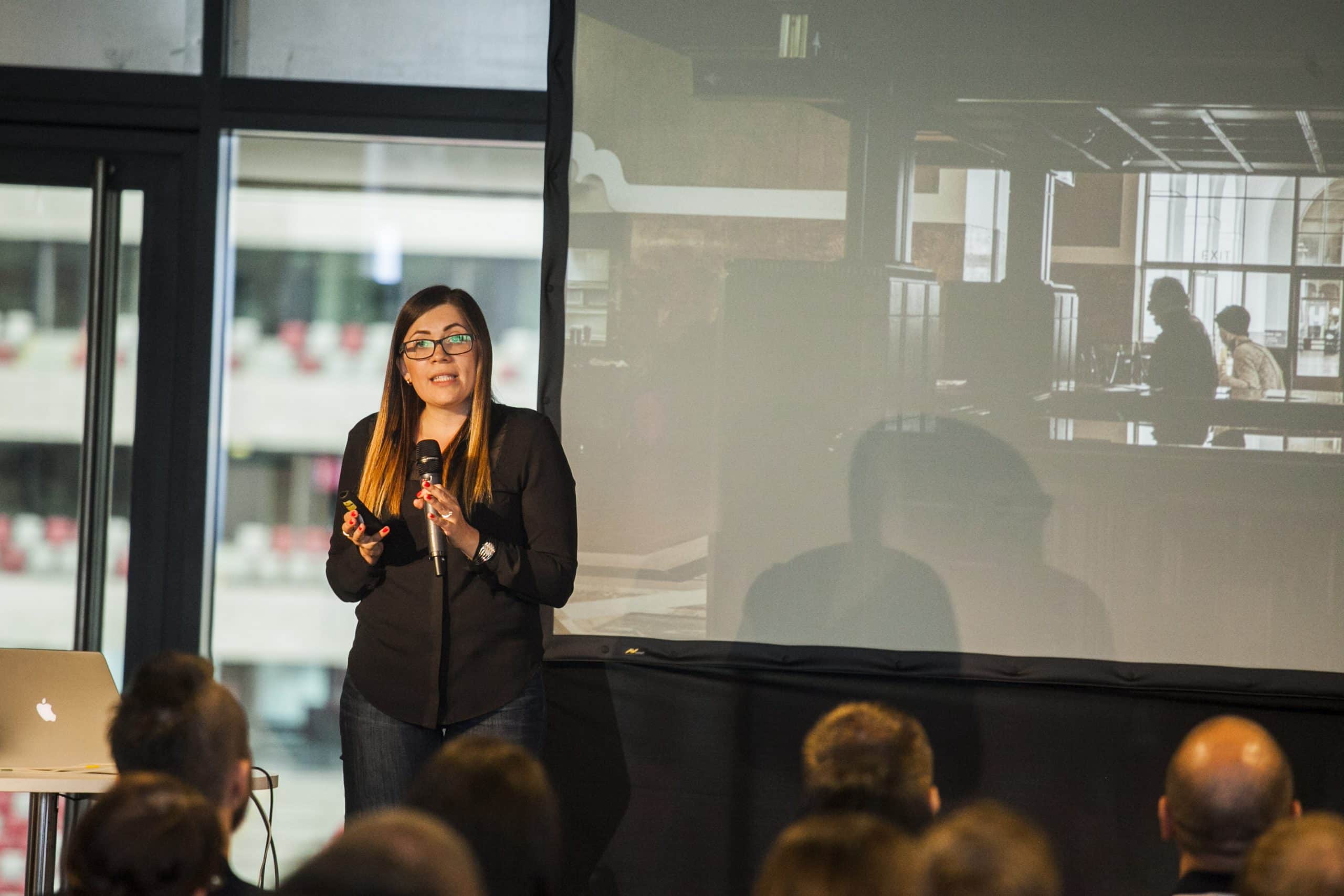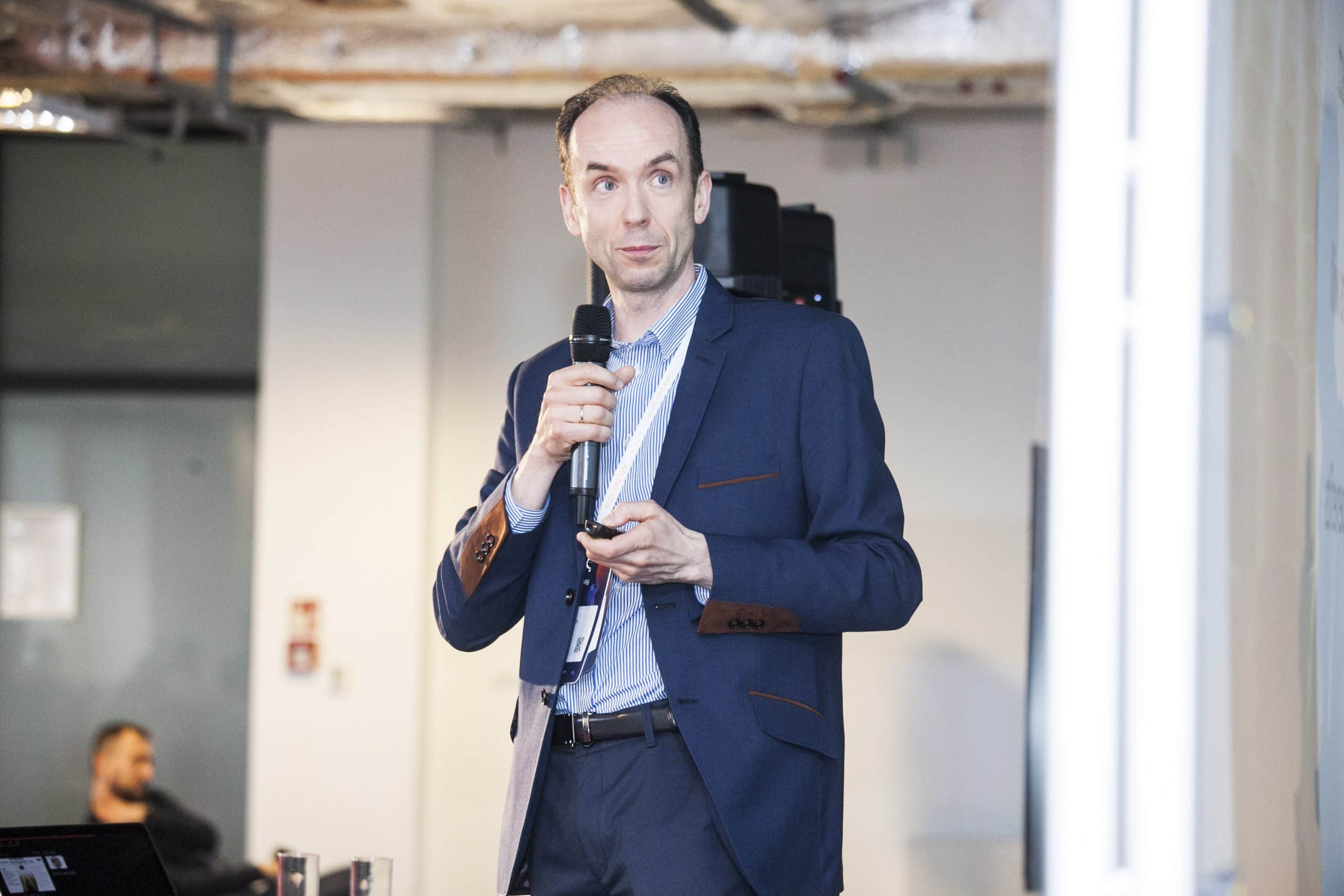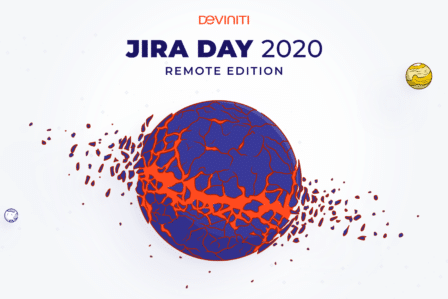What was going on at Jira Day 2019?

Over the last 5 years, we at Deviniti have organized over 20 events related to Atlassian products. Jira Day is the biggest of them, and it’s the largest conference of that type in Central and Eastern Europe. Well, some even claim it the largest non-Atlassian-owned event in the world! However, each year Jira Day is truly growing and becoming more international.
During this year’s edition, which was seventh in a row, there were more than 400 attendees from 18 countries, 26% of whom were from outside Poland. 45 expert speakers and 15 Marketplace vendors added to our own 40-people crew at the PGE National Stadium in Warsaw with presenting their products and sharing knowledge from their experience, as well as the April’s Atlassian Summit held in Las Vegas. Here’s a brief report of what we were talking about.
Special guests from the Atlassian Ecosystem
Houston, we have Jira, we don’t have problems.
.
This was the motto of Jira Day 2019, presented at the event’s opening speech by our CEO Piotr Dorosz. Piotr showed how in the modern world, where technology accelerates exponentially, wonderful things are built with the help of software tools like Atlassian. The same idea was developed further by Feico Mol, Atlassian Head of EMEA Channels, who performed a kind of a time journey to track the way people used to work from the first industrial revolution in 1784 up to modern days. The process of producing goods transformed itself a lot over time: from manual production, through Fordism, it came up to the point where data is most valuable, and people build software to help other people build other software.
Teamwork practices changed accordingly. Even 30 years ago, most of us used to come to work for 8 hours a day and then leave, forgetting about it and becoming easily unavailable for the co-workers. Now that technology permeated our lives, we’re always online, often work remotely, and thus communicate through software tools rather than face-to-face. There are pros and cons to it, but to maintain a good balance, we need the right mix of people’s characters, tools they use, and practices to enable communication between all of them. Fordist approach to teams as conveyor belts isn’t effective anymore as well, because teams become cross-functional and often can decide about the comfortable pace of work on their own. Also, when knowledge is the source of work being done and not the physical effort, a touch of personality and autonomy becomes more valuable than strict standards and predictability, and energy becomes a more valuable resource than time. These changes also affect companies’ approach to leadership, which starts guiding instead of mandating, delegating responsibility and emphasizing the importance of communication across and between teams. The most important practices Feico mentioned were setting OKRs instead of KPIs, automating repetitive tasks and leveraging the Atlassian Team Playbook.
The keynote itself had an interesting twist, too. At some point, Feico proposed an exercise: he asked the audience to turn to each other and talk a bit about the current problems in their companies. Then he left the stage, and for a couple of minutes the attendees were left on their own, but they didn’t even notice it, so they were engaged in the discussion!
After the keynote, HP Indigo’s Atlassian Team Tech Lead and Israel Atlassian Community co-leader Tanya Gordon took over the stage with a story of how Atlassian software helps them implementing lean product development successfully. Shared project schemes, sprint cadences, and versions’ lists in Jira helped them streamline the production process and distributing tasks between working teams. The team also had to define clear permissions via project roles, extend the out-of-the-box default assignee concept and create a cross-team issue navigator with advanced JQL. To increase transparency and availability of project data, they make use of BigPicture boards and custom per role reports set up in eazyBI.
Proper knowledge management is of high importance as well for big LPPD teams. At HP Indigo, they’ve created generic templates for so-called organic teams’ and working teams’ spaces in Confluence. Each of those would contain different sets and structures of content. The next issues were automatic labeling and easier searching for pages, which they’ve solved with creating custom page templates and using Brikit Targeted Search for Confluence.
As we can see, even though our event is called Jira Day, it’s not dedicated exclusively to Jira, contrary to a common opinion. For another example, this time we managed to have the Ecosystem superstar Serhat Can as a speaker! The Opsgenie engineer and ambassador, who is now one of the most wanted guests at IT conferences around the globe, went on stage during the first day with a thrilling narration about incidents.
Did you know that even if we have 99,9% uptime, which is already a difficult task, it can still be not enough for our customers, because it is in fact 8,76 hours a year offline?
.
This is especially difficult if you’re serving someone like 911, who can’t ever have a single moment of an outage. Different sources provide different IT downtime cost, but the figures are always impressive, as the global estimations vary from $700 billion a year to an astounding $4 billion a day! What’s more, after a major data loss many businesses simply shut their doors and can’t go on anymore.
So the goal here for the Turkish team along with Atlassian was to build a centralized DevOps-compliant workflow for alerting, notifying, escalating, fixing and learning from incidents, which happen inevitably if a company works with or relies on data. To accomplish this, they had to make their software integrated with over 200 different tools used by both Dev and Ops teams at work, as well as allow to execute on-call alerting via SMS, phone calls or push notifications. Recently, the team has added postmortem reports, automated actions, and other features they announced at this year’s Atlassian Summit.
Jira Software talks
Nevertheless, Jira is still the king (or should I say the queen?) of Jira Day, mainly due to the continuous growth of this tool’s adoption. This shouldn’t be a big surprise, as Atlassian reports around 40% year-to-year growth and a total of 150,000 customers to date. Companies across all Central and Eastern Europe are still discovering better ways to track their work, so topics like implementation, migrations, or setting up such tools have always been a big chunk of the event’s agenda. For example, independent Atlassian Consultant Bogdan Górka described the most common pitfalls he comes across on each stage of greenfield Jira implementations. Among them are:
- ignoring the impact of implementing a tracking system on the whole organizational culture;
- not documenting the objectives of having one in place;
- assuming that Jira is for the executives and not for the actual teams;
- not providing the expected users of the system with appropriate training;
- authorizing everyone in charge of projects making changes on the whole instance;
and many more. The general message of Bogdan’s talk was that when the decision of implementing Jira is made, it should be supported by people on each level of the organization to be successful. The topic is eagerly discussed among starting admins on the Atlassian Community as well.
This year’s edition of the conference can be also marked as the one having most Atlassian attendees as well as speakers. For instance, Senior Product Managers Jakub Kurcek and Małgorzata Kowalska shared the news about Jira Software 8.0 and Portfolio for Jira 3.0, and Senior Software Engineer Ilya Zinoviev told the history of developing Jira Data Center.
The first-ever announcement of multi-node Jira took place at 2012 Summit. Back then, it was suggested that ‘people took Jira out from the server under their desk and put it in their Data Center.’ But a couple of years later, it turned out that not only the business giants wanted to benefit from availability during reindexing and higher performance of their large instances, but also their fast-growing peers, who could not afford or didn’t want to host their own data centers. So Atlassian redefined the mission for their enterprise offer in 2016, right after the idea of their infrastructure move to AWS emerged, code-named Vertigo. Since then, companies could deploy Jira Data Center to a cloud infrastructure such as AWS or Azure, thus achieving more flexibility. Other key features developed over time were zero downtime upgrade, project archiving and native SAML support. Right now, the team is working on full GDPR compliance of the product, archive browsing, and CDN integration.
In his turn, Senior Quality Engineer Michał Warkocz brought some insider tips about how reported bugs in Jira Server and Data Center are collected, prioritized and eventually fixed. The team’s prioritizing factors include:
- security of the product, which is not only sourced by customer feedback but also investigated proactively;
- reliability at scale (stability issues, data loss, downtime);
- minimizing the number of issues between Enterprise Release versions like 7.13 and 8.5 to be released in the third quarter of this year;
- and the feedback from Atlassian’s own Jira, which includes all the metrics available there from impact scores to the number of watchers and comments on appropriate issues.
It’s interesting to note that since Jira 8.0 release, 39% of all reported bugs have been already fixed, and another 7% is currently in progress. The rest is being triaged and assessed to include the fixes into the upcoming versions.
When Jira becomes the central point of communication inside and between teams in a company, relationships between software and its users start resembling those between humans. People are so different, and so are the tools we use, that sometimes it seems we are from totally different planets. So our own Senior Atlassian Apps Manager Katarzyna Pawlak claimed Jira being from Mars and its users being from Venus, paraphrasing a famous bestseller book by John Gray. The point was, the source of the frustration people often have about Jira is improper understanding of either the tool’s possibilities or the users’ actual needs. This results in a lack of communication inside a team, between customers and support agents, or even between analysts, developers, and testers working on the same project. Luckily, in contrast to human relationships, most of our problems with Jira can be solved with the help of dedicated apps. Kate reminded that we at Deviniti for 15 years have been helping improve customer and agent experience through Jira Service Management, let teams work faster and easier in Jira Software, and bring requirements and test management right inside your Jira with both our products and services.
To exemplify that customized Jira can speed up the teams’ work even in a distributed environment, an interesting case was presented by Lionbridge’s Product Manager Michał Cieślak. Their global content production team receives 38 thousand requests monthly and often has less than 24 hours turnaround time. Over a hundred certified linguists and over a thousand more community members, all situated globally, process these requests and localize content for their clients. Aside from obvious management complications resulting from this situation, like assigning the tasks to the right people and ensuring a smooth workflow, a couple of technical issues arise here as well. Importing tasks via native Jira API created many duplicates, as the same task could be assigned to multiple possible executors. So the team customized the REST API to process issue creation requests in groups and create assignments inside one task, which reduced the issue volume from over 10 thousand to less than 2 thousand a day. Also, small tasks needed to be grouped into packages, which creation reduced from 2 minutes to just 3.3 seconds just by increasing the frequency of re-indexing during the package creation. Also, the team featured a text word count and Dropbox file streaming right on their issue view to streamline all the activities related to the content. These and other improvements helped increase on-time delivery from 82% to 96% within 3 years.
Jira Service Management talks
The Atlassian ITSM tool also has been on the rise lately, as the DevOps approach has become a must in many companies, and support teams benefit from sharing the working environment with developers. Jira Service Management has lots of possible use cases for both internal and external customers, some of which were presented at Jira Day 2019 as well.
One of the biggest challenges of customer support in big enterprises is streamlining the process of accumulating customer requests in one place. Sebastian Krzewiński, who presented his experience of implementing Jira Data Center at Allegro last year, this time explained the case of reorganizing customer support in Żabka – one of the biggest Polish retailer franchises. While previously Sebastian worked with Atlassian software in the context of IT support in e-commerce companies, now he found himself in a completely different situation. The customers didn’t always have the technical knowledge, which required making the Customer Portal as simple as possible. What’s more, different teams supported different areas (finance, security, etc.), but were all on the same organizational level, which caused them to have many sources for issues. What he did was a gradual move from many points of contact to one with the help of Jira Service Management. One team is serving the first support line now, and they manage to resolve most issues right away. If this doesn’t happen, they pass the tasks over to the Level 2 teams who operate on a different project. The issues between the projects are synchronized with our Issue Sync app, so all the teams are on the same page, but the communication with the customers is performed only on the first line project. The final step is to eliminate all the issue sources except for the first support line.
Another common problem of IT teams is passing the requests through multiple acceptance stages and enabling close collaboration between support lines and the development team. This is what adding Jira Service Management to the suite and customizing it can solve brilliantly if the rest of the team already uses Jira Software. Artur Karpisz, the IT Project Manager of Alior Bank, one of the biggest players on the Polish market, explained how they managed to set up the whole process inside Jira – from submitting an idea up to final acceptance, implementation, and maintenance. This is not an easy task, especially for a company that has 8053 Jira users, a total of 125 projects, 138 workflows, 887 custom fields, and a total of 477 679 issue volume to date. The team required significant customization of their instance, involving 16 apps from the Atlassian Marketplace and a couple of in-house developed add-ons and scripts, to make the software do the exact job they need. The improvements they’ve made to out-of-the-box Jira were:
- the Project Charter on the issue view, which contains information on the implementation progress of individual environments of a new system and automates creating sub-tasks for each one;
- copyright registration for the people willing to protect their code from fraud, hand over for managerial acceptance based on reporters’ Active Directory attributes;
- optimizing request forms with dynamic or bundled custom fields, as well as displaying SLAs and linked issues on the request view;
- automatic escalation of users’ lack of response and closing the tickets after deadline expiration for either supplementing the data or verifying the completed tasks;
- synchronization of Select custom fields’ options with the contents of the knowledge base in Confluence;
- parallel acceptance and automatic processing of customer requests;
- cross-project queues of requests involving both Jira Service Management and Jira Software projects;
and more.
Automation has recently become one of the hottest topics in many areas from logistics and healthcare to software testing and ITSM. While experts like Atlassian resident Work Futurist Dom Price are rather skeptical about machines substituting humans in customer support, businesses are naturally seeking ways to make software work together with humans to deliver the most effective output. London’s Atlassian Community Leader Tom Harris specializes in automating Jira Service Management and dedicated his stage time to explaining why, what, and how to automate this Atlassian tool. Generally speaking, the turning point to decide for automation is when the cost of implementing and maintaining it is lower than the cost of human employees doing the same job. At a certain scale, it’s more effective in terms of time, too! Simple math shows that by automating a monthly task which one person has worked on for one hour, we’ll save 2 full working days across 5 years. Multiply this by, say, a hundred employees, and you can get the point.
In Jira Service Management, there’s a lot of actions which can be automated instead of being executed manually upon certain triggers and conditions: assigning requests, changing their statuses, updating linked Jira Software issues and vice versa, notifying the request participants, and much more. They may seem small, but when they all add up, the effect is instantly visible, as the support teams work easier, and the customers see their requests resolved faster.
Atlassian Marketplace apps news
The Marketplace vendors who came to the conference were presenting the latest releases and updates to their products, too. For instance, our German peers from re:solution came to show off their newest additions: Language Translation for Jira Service Management, which helps translate requests’ summaries and descriptions with the Google Translate engine, and User Deactivator for Jira, which they’ve recently acquired from Riada. The latter in their turn have added ITSM project templates and reports to their Insight CMDB platform for Jira Cloud. Lucidchart showed up in Poland for the first time with their diagramming solution, as they’ve recently become our new Partner, and Tempo has just released a mobile app for their time tracking app on Jira Cloud.
Our own Apps team had a couple of big releases to show as well. Katarzyna Pawlak and Michał Sztuka presented Theme Extension for Jira Service Management – our brand new solution for redesigning the Atlassian customer support tool and applying a brand style to the Customer Portal view. Natalia Korybska and Jarosław Solecki explained how to complete software projects in Jira by bringing requirements and software testing inside the tool with our newest addition, Requirements and Test Management for Jira.
Something else?
Sure! Atlassian Ecosystem events like Jira Day are not only about gathering and listening to talks and watching demos, but also about casual networking and making friends. In the expo hall, we had a feedback wall, where everyone could leave an honest opinion about the Atlassian software they use. After the first day of the conference, it was enough to go a couple of floors downstairs to get to a stadium party with a dancefloor, VR games, an open-air terrace with a view of the gorgeous stadium, as well as lots of delicious food and drinks. During the two days, the attendees were to play the Passport Game, which implied going through all the vendors’ booths, gathering branded stickers from them and then taking part in a prize lottery that ended the whole two-day Jira adventure.
However serious the topic of enterprise software is, during such events everyone is making lots of fun, including us as the organizers! We’re proud to make Jira Day happen every year for seven times in a row, and on May 27-28th 2020, the event will be there again. Let’s have fun and share knowledge together next year!
Thanks a lot to all the event’s sponsors and partners who contributed a lot to it: Communardo, eazyBI, re:solution, Riada, SoftwarePlant, ALM Works, Comalatech, DEISER, K15t Software, Lucidchart, META-INF, Refined, Spartez, StiltSoft, Tempo, justgeek.it, justjoin.it, No Fluff Jobs.
Also published on Dimitry’s LinkedIn.










